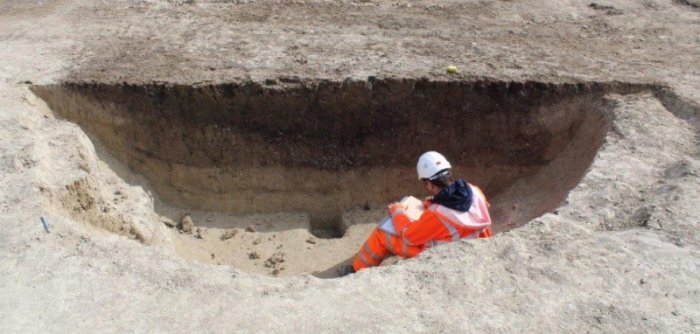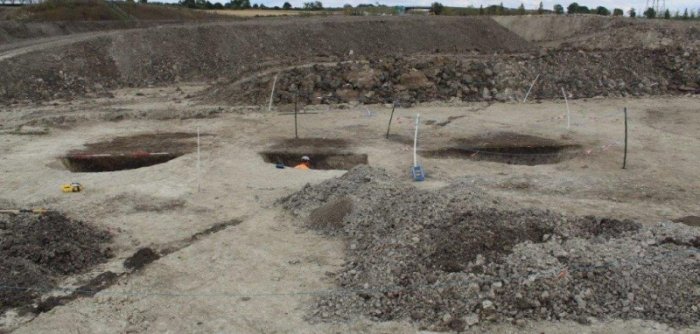Conny Waters – AncientPages.com – Archaeologists excavating in Linmere, Bedfordshire, UK, have discovered 25 monumental pits in what has become a nationally important prehistoric site.
The site date from the Mesolithic Period (12,000-6,000 years ago), a time with few clues to suggest what life was like in Britain.

An artist reconstruction of the pits / Hugh Gatt – Image source: MOLA Archaeology
MOLA archaeologists report the site was excavated during two separate projects. Albion Archaeology worked on one area in 2019 for Lands Improvement Holdings Ltd (LIH) and MOLA excavated part of the site ahead of a Bellway Homes housing development in 2021.
The unusual pits were discovered during both digs, and recent radiocarbon dating revealed their extraordinary age (8,500 – 7,700 years ago). This puts them squarely in the late Mesolithic period (9,000 – 6,000 years ago).
Why Is The Mesolithic Site Important?
This date makes the site incredibly significant because there are very few Mesolithic sites in the UK that are this substantial. Evidence from this period is often slim, only consisting of flint tools and occasional butchered animal remains. This makes it difficult to build up a picture of what life in Mesolithic Britain was like.
“It’s been amazing for the whole team to work on such a significant Mesolithic site. It really shows how important radiocarbon dating is alongside field work, as without it, we wouldn’t have realized the significance of our discovery,” Yvonne Wolframm-Murray, Project Officer, said.
During the Mesolithic period, ice sheets covering much of the country retreated, and sea levels rose, cutting off Britain from mainland Europe. It’s a crucial time of transformation in the UK’s past, and studying a site where people made such a mark on the landscape could have far-reaching impacts on how we understand these ancient communities.

Credit: MOLA
These kinds of pits have been found in sites across Britain and France, but mostly in sparse numbers. Even the landscape surrounding Stonehenge, which contains thousands of prehistoric pits, only has five dating to this period. The pits at Linmere are very similar to those around Stonehenge, both in date and the number of finds.
What’s In A Pit?
The Linmere pits were all round with very steep sides, and some flared out at the bottom into a wider base. Measuring up to 5 meters wide and 1.85 meters deep, it would have taken a lot of effort to dig even a single pit.
The pits appear to be laid out in multiple straight lines, up to 500m long. There are other Mesolithic pits dug in alignments in Britain, but in Linmere these alignments are clustered around former stream channels.
As people in Mesolithic Britain were nomadic hunter-gatherers, digging 25 would have been a monumental task.
“The Linmere Mesolithic pits are a very exciting discovery. While we know of other large and enigmatic pits dug by hunter-gatherers from elsewhere in Britain, including at Stonehenge, the Linmere pits are striking because of their number and the wide area they cover,” Professor Joshua Pollard, Southampton University said.

Credit: MOLA
Inside some of the pits were a range of animal bones, a crucial source of evidence. We found the remains of several wild species, including aurochs, marten, deer, and boar.
Aurochs were a wild species of cattle, and there was evidence on the bones that people were eating them. It was these bones that were radiocarbon dated, revealing the pits were 8,000 years old.
Why Did They Dig So Many Pits?
There are several theories about what these monumental Mesolithic pits were for, from being used in hunting to storing food. However, the shape and size of these pits make these theories unlikely.
Alternatively, the amount of effort required to construct the Linmere pits, the fact they’re in alignments, and their location next to water mean they could have some ritual or special significance. For example, they could mark an important place in the landscape.
Archaeologists are carefully studying whether the pits are aligned on any major celestial events such as the solstice. The next step is to continue the work on Linmere in the lab, radiocarbon dating more animal bones and analyzing environmental samples to learn more about the ancient landscape.
“We are hoping to discover whether the pits were all dug and in use at the same time, as well as understanding more about the plants growing nearby. We have already identified evidence of oak, hazel and pine, and are now studying tiny pieces of pollen,” MOLA said in a press statement.
This work will reveal the environment these people lived in, and hopefully answer the big question “what were these pits for?
Written by Conny Waters – AncientPages.com Staff Writer





